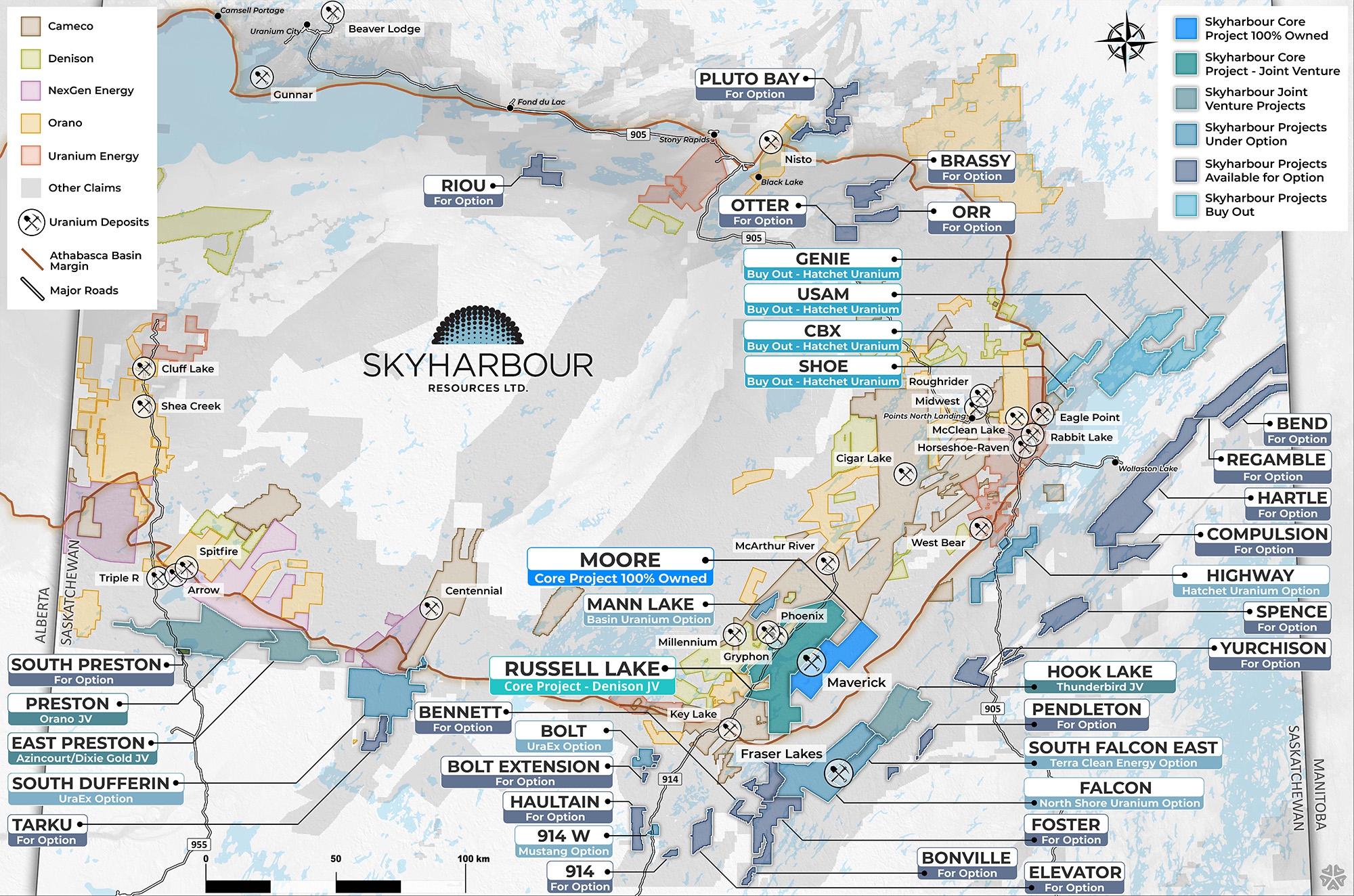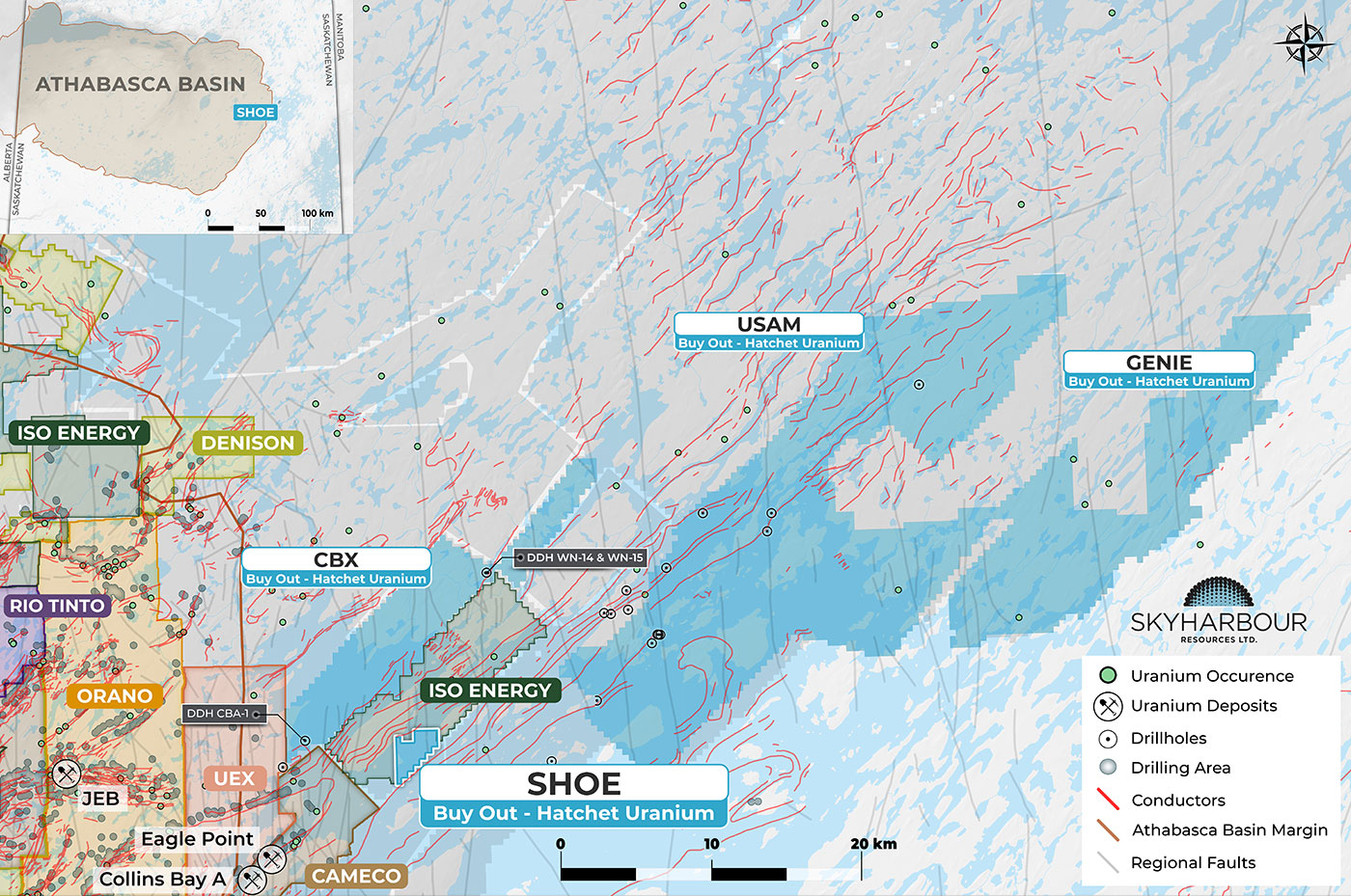Highlights:
- The CBX/Shoe property has been expanded to include five additional claims, now totaling eight non-contiguous claims across 9,386 hectares, located 6.5 to 25 km north-northeast of the Eagle Point uranium mine
- The property is underlain by Wollaston Supergroup metasedimentary gneisses, Hudsonian intrusives, and Archean felsic gneisses, similar to uranium-hosting lithologies in the Rabbit Lake operation area
- The CBX project is considered highly prospective for unconformity-related and basement-hosted uranium, pegmatite- and granite-hosted uranium and REEs, and molybdenite, with previous evidence of sedimentary-hosted molybdenite and pyrite in fractures
- No modern exploration has been conducted on the newly expanded claims, although adjacent properties have undergone modern exploration
- Skyharbour has entered a Purchase Agreement with Hatchet Uranium, where Hatchet can acquire a 100% interest in CBX/Shoe and related projects, with Skyharbour retaining a 2% NSR, half of which can be bought back for $2M
Project Summary:
The CBX property has been recently expanded through staking to include five additional claims adjoining the previously staked CBX and Snow properties, which have been combined to include a total of seven claims covering 8,777 hectares. The 609 ha Shoe property has remained unchanged, with both CBX and Shoe now consisting of eight non-contiguous claims totalling 9,386 hectares. The new claims lie approximately 6.5 km to 25 km north to northeast of the Eagle Point uranium mine and cover the northern shore of Wollaston Lake including parts of Cunning Bay. Outcrop exposure on the property is poor, but historical mapping and drilling shows that the newly expanded CBX project is underlain by a mixture of Wollaston Supergroup metasedimentary gneisses, Hudsonian intrusives, and Archean felsic gneisses of the Western Wollaston Domain. Similar lithologies host uranium mineralization at the Rabbit Lake operation, including the Eagle Point deposit, and other uranium deposits in the Athabasca Basin and surrounding regions.
Like the previously staked CBX claims, these new claims have seen a variety of historical exploration conducted mainly between 1968-1981, including airborne and ground EM, magnetics, and radiometrics surveys, marine seismic surveys, prospecting, geological mapping, and geochemical, with some additional work in 1993. There was also a limited amount of historic drilling in 1979-1980, including drill hole CBA-1 on the Cunning West Grid in the southeastern end of the property, and two diamond drill holes, WN-14 and WN-15, drilled in 1980 in the north-central part of the property on the Ross Channel Grid. All three drillholes were shallow (<100 m depth) and successfully intersected variably chlorite-altered graphitic biotite gneiss, with local pegmatites and graphitic fault gouges, however no geochemical samples were taken from these drill holes. These new claims have seen no modern exploration, although drilling and other modern exploration have been done on adjacent properties. The CBX property is prospective for unconformity-related, basement-hosted uranium mineralization, pegmatite- and granite-hosted uranium and REEs, and for molybdenite, as sedimentary-hosted molybdenite and pyrite were identified in fractures in a quartzite outcrop on the property (SMDI 4890).
Skyharbour recently entered into a Purchase Property agreement with Hatchet Uranium Corp. whereby Hatchet may acquire a 100% interest in the Genie, Usam and CBX/Shoe projects by paying Skyharbour $25,000 and issuing to the Company such number of units in the capital of Hatchet equal to 9.9% of the issued and outstanding Shares immediately following issuance. Skyharbour shall also retain a 2% net smelter returns royalty from minerals mined and removed from the Purchased Property, of which Hatchet may purchase one-half, being 1%, at any time for $2,000,000.



